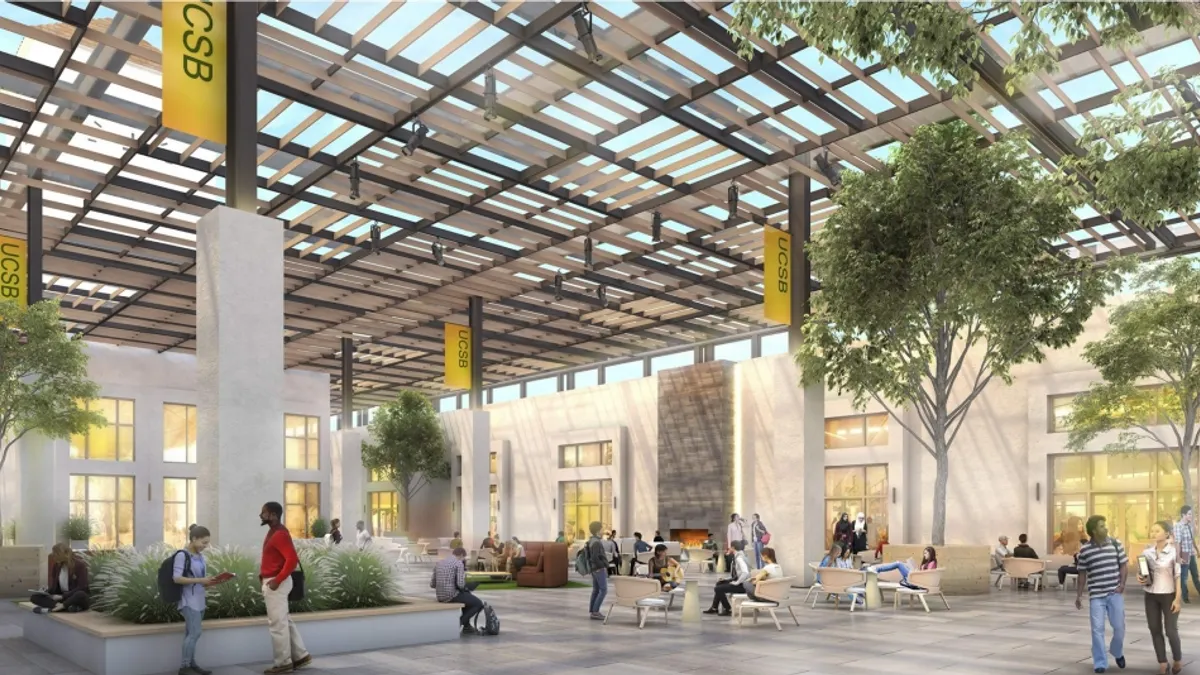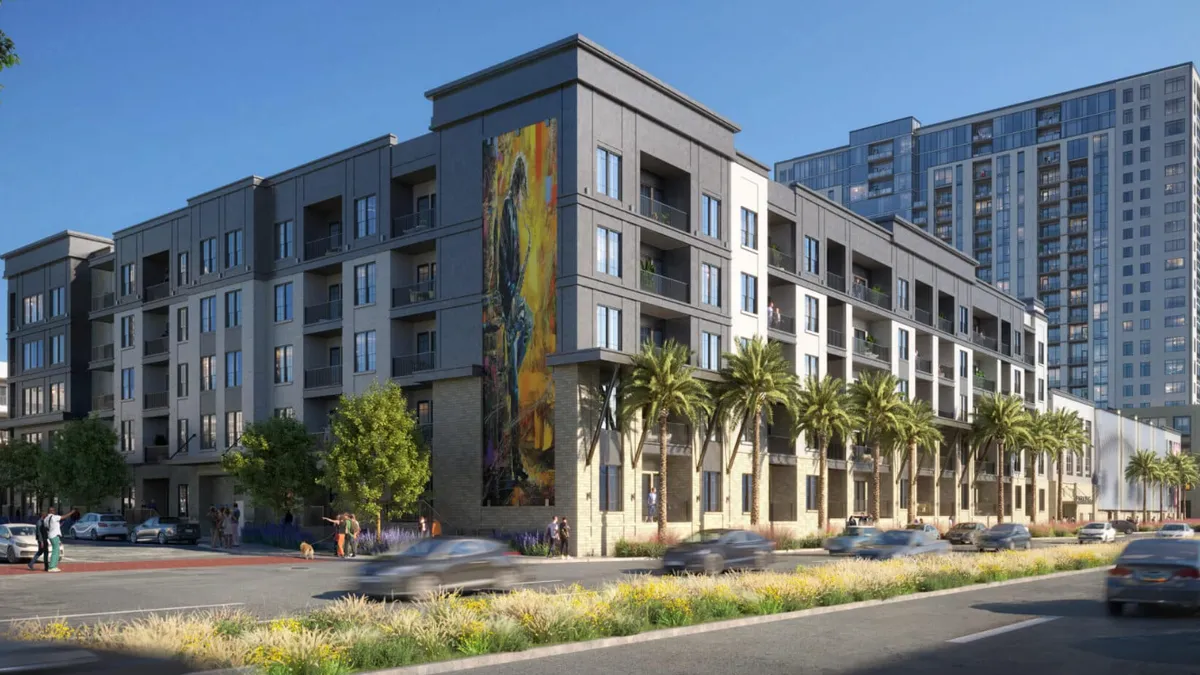The University of California at Santa Barbara is in the midst of a long-standing student housing crisis. It's so bad that some students are living out of their cars, according to Richard Wittman, an associate professor in the Department of the History of Art & Architecture at UCSB.
Charles Munger, a 97-year-old Berkshire Hathaway executive, is offering a solution in the form of Munger Hall, an 11-story, 1.68 million-square-foot structure that would house 4,500 students in suites with single-occupancy bedrooms.
But there's one problem: 94% of the bedrooms at Munger Hall have no windows. And, Munger is contributing $200 million to the dorm's construction on the condition that no changes are made to his design.
The project has some in the community up in arms. Dennis McFadden, who had served as an architectural consultant on UCSB's Design Review Committee, has resigned in protest of the project and the process of its approval. In his resignation letter, McFadden refers to Munger Hall as "a social and psychological experiment with an unknown impact on the lives and personal development of the undergraduates the University serves."
Despite these concerns, the project is continuing to move forward as the university looks for ways to build housing to match its surging enrollment.
Over the past decade, following the 2010 Long Range Development Plan and mandates from the state of California, UCSB has increased its enrollment. But it has only built a fraction of its planned new housing, according to The Santa Barbara Independent.
When asked about the current state of housing at UCSB, Kimberlee Keithley, a fourth-year Ph.D. student at UCSB and anti-Munger Hall organizer, told Construction Dive that the waitlist for undergraduate on-campus housing was "extremely difficult" to get on and the university encouraged some students not to add their names.
Munger moves forward
On June 18, a coalition of community groups known as Sustainable University Now accused UCSB and Chancellor Henry Yang of breaching its agreement to cap enrollment and provide new housing, resulting in housing shortages and rising costs in the surrounding communities.
Sustainable University Now set an ultimatum of July 18 for the university to provide a detailed plan to resolve its shortages. Campus authorities announced the public review period for Munger Hall, first approved in 2016, three weeks later.
Living arrangements at Munger Hall would consist of eight single-bedroom suites, which would be arranged in 'houses' of eight suites, with eight houses to a floor. In total, there would 512 rooms per floor. The majority of the single-occupancy rooms — 94% — are windowless. Each suite would include a communal area and kitchenette, and each house would have a common full kitchen, laundry facilities, great room and game room. Windows would be located in each house's common areas, which are arranged on the floor’s outer perimeter.
At a density of 221,000 students per square mile, McFadden notes that Munger Hall would qualify as the eighth-densest neighborhood in the world, housing the equivalent of the entirety of the undergraduate population at Princeton University.
The living spaces will be constructed as modular units off-site. On-site amenities would include a fitness center, recreation spaces, study rooms, dining facilities, a market and a courtyard space on the 11th floor.
Munger Hall is currently undergoing an Environmental Impact Review process, according to UCSB, during which additional public feedback will be solicited. The project is pending approval from the County of Santa Barbara, the University of California Regents and the California Coastal Commission, according to The Santa Barbara Independent.
The soonest the building is anticipated to open for occupancy is fall 2025. No other housing projects are in the works on campus.
Local pushback
Following McFadden’s resignation in October, Munger Hall — nicknamed "Dormzilla" by the Santa Barbara Independent — has been the subject of various news articles, op-eds and pushback from students, parents and faculty.
A number of student activist groups, including Food Not Bombs Isla Vista and UCSB for COLA, or Cost of Living Adjustment, recently united to protest Munger Hall and advocate for student hotel contract extensions, according to Keithley. Two Change.org petitions opposing the project, one organized by UCSB student Tommy Young and another by a coalition of faculty known as the UCSB Architectural Historians Group, have gained a combined total of 16,000 signatures.
Most recently, a group of former UC campus architects submitted a letter of opposition to the UC system's president, Michael Drake, and its board of regents, claiming that at an estimated $330,000 per bed, Munger Hall would be the most expensive housing project in UC's history.
"The building would have a level of density that is kind of unprecedented in this kind of building. There's all kinds of things about it that are unprecedented," Wittman, a member of the UCSB Architectural Historians Group, told Construction Dive. "It’s not even legal to build a jail with windowless cells."
At a recent meeting between faculty and university administration, questions about whether the university had done research into the effects of Munger Hall's density and lack of windows in sleeping areas on the well-being of students were met with silence, according to Wittman. (UCSB did not respond to requests for comment on this incident in its statement to Construction Dive.)
"I think people are not going to want to come to the university [if Munger Hall is built]," Wittman said. "It will make a mockery of the university's commitment to sustainability because this building is anything but architecturally sustainable."
Promoting the Project: 'Absolutely Stunning'
In the wake of backlash about the project, UCSB has demonstrated enthusiasm for Munger Hall through its in-house news publication, The Current. In a July article entitled 'Absolutely Stunning', staff writers state that Munger Hall's living arrangements will "maximize individual space for students and provide a living environment unparalleled in undergraduate housing," and anticipate that its construction will alleviate density issues in neighboring communities.
In November, The Current published a "Munger Hall Q&A" page, written by former Executive Vice Chancellor Gene Lucas, with the stated intention of clearing up misconceptions about the building's design.
Lucas emphasizes that students will continue to have other options in more conventional university housing, and that "Munger Hall will be available to those who prefer it." He notes that the building meets code — the California Building Standards Code allows building owners to use mechanical ventilation and artificial lighting as a substitute for windows.
Each bedroom without a window would include a "virtual" artificial window, Lucas said, and common areas within each house at Munger Hall, including Great Rooms and kitchens, would have access to natural window lighting. The design team anticipates that students will spend more time in common areas than in sleeping areas.
In response to this Q+A, Wittman said, "This is what it looks like when the same people who write the As are those who wrote the Qs… Instead of looking at the density issues in [the nearby community of] Isla Vista, and trying to come up with a solution that relieves students of living in those conditions, [Munger Hall] does the opposite. It takes that as the new normal, and says, we can give you the same level of crowding, but we'll give you your own room, and it will be a nice, clean building. You won't have a window, but life is a trade-off."
When asked about the university’s current housing situation, UCSB provided the following statement to Construction Dive:
"The campus is currently housing more than 10,000 students in on-campus residence halls. Munger Hall...will be only one of [the] on-campus residence halls and apartment housing options available to students to select from. Campus housing is typically 15 to 20% below market value. We believe given its amenities and private rooms, Munger Hall will be a top choice for many students. Students will also have many off-campus options if that is a better fit for them.
"At the start of fall quarter (September 20), the university was able to offer housing to every undergraduate who applied for housing by the deadline (July). In addition, the university was able to offer a contract to even the students who contacted us for the first time the week before classes started, although some of these were offered hotel rooms. Every undergraduate student who applied for housing this fall was offered a contract."


















